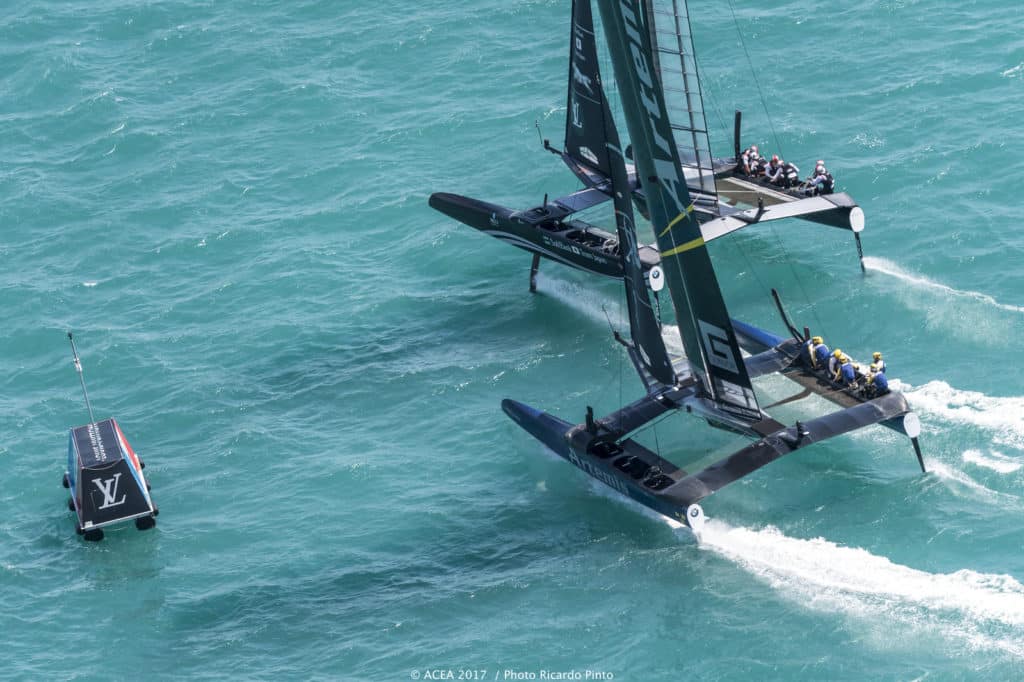
Since the America’s Cup shifted to a multihull class for the 2013 (AC72) and 2017 (America’s Cup Class) events, there has been more passing in the racing than ever before.
Even if the races are much shorter, passing opportunities open up as the larger speed differentials mean any mistake is immediately and severely punished.
That being said, one truism of the old America’s Cup remains – it is better to win the start and lead around the race track, than to be chasing the race from the off.
The stats bear this out.
In Round Robin 1 of the Louis Vuitton America’s Cup Qualifiers there were 15 races sailed. The winner of the start went on to win the race 9 times (it would be 10 times, as one of those wins – NZL over SWE, was due to an admitted error by the Umpires).
For the purposes of this analysis, we didn’t always award a win in the start to the first boat across the line. In the last race of the opening round, for example, Groupama Team France cross the starting line ahead of SoftBank Team Japan, but the Japanese team was only a second behind and going 8 knots faster. That has to be judged as a startline win to Japan.
In the few situations where the boats crossed the line all but simultaneously and at similar speeds, the leader at the first mark was judged the winner of the start.
In Round Robin 2, winning the start was even more powerfully associated with winning the race.
In three races the team that lost the start overcame that early deficit to win. And arguably, it happened only twice. In race 5, although Land Rover BAR beat Emirates Team New Zealand across the line, the Kiwis had 4 knots more speed, were gapped off to windward and closing so quickly they pressured the British team into a mistake immediately after rounding mark 1. Race over.
It’s too early to say whether this increased association between winning the start and winning the race is a trend. The teams are still learning how to sail these new boats and the pre-start playbook is being written – ahem – on the fly.
ORACLE TEAM USA skipper Jimmy Spithill had two good starts on the final day of the Louis Vuitton America’s Cup Qualifiers, beating the Kiwi Peter Burling (who started under penalty) and his British rival Ben Ainslie (who started well behind and 5 knots slower).
Spithill was quick to attribute his team’s success to the work he’d been doing with coach Philippe Presti and tacticians Tom Slingsby and Andrew Campbell, saying they’d been working on pre-start plays to give them an advantage off the starting line.
And Martin Whitmarsh, the CEO of Land Rover BAR is sounding bullish on his team’s prospects in the Louis Vuitton America’s Cup Challenger Playoffs against the top ranked challenger, Emirates Team New Zealand, in large part due to a faith in Ben Ainslie’s match racing nous.
“We’ve had some great starts,” Whitmarsh told The Telegraph (UK) newspaper, “I think Ben can really hustle them in the pre-starts and I think they must fear that. And in these conditions, and as the wind picks up, anything can fail, anything can happen, any mistake is going to be heavily penalised.”
With the Challenger Playoffs now underway in a Semi Final >> Final format where teams are paired up against each other, watch for the pre-start playbook to evolve as the competitors become more familiar with each other.
Similar to an NFL team that can make adjustments at halftime to counter a strong opponent, whichever America’s Cup team can best evolve, adapt and improve in this crucial three minute period before the race starts is likely to emerge as the top challenger.
Of course there’s another old truism that ALWAYS applies… It’s better to win the finish than to win the start. But as we’ve seen above, winning the latter dramatically increases the chances of winning the former.









